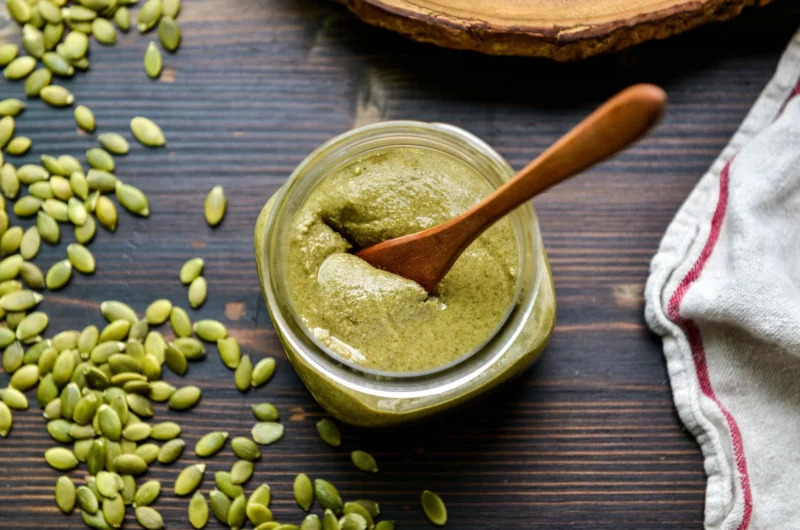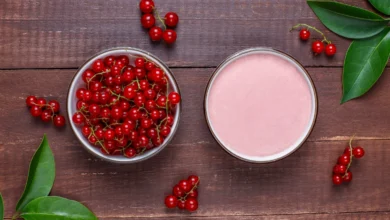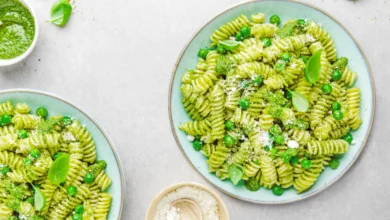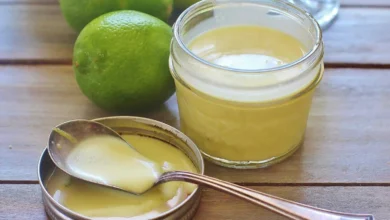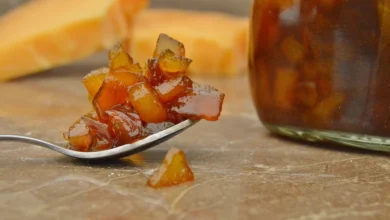Homemade Pumpkin Seed Butter: Easy, Healthy & Delicious

Okay, confession time: “nut butter” is a bit of a misnomer. I get the tradition, but sometimes the best things happen when you break the rules…like with pumpkin seed butter.
Contents
- Homemade Pumpkin Seed Butter
- What Do I Need to Make Pumpkin Seed Butter?
- Homemade Pumpkin Seed Butter Recipe
- Ingredients
- Directions
- Notes
- Does Pumpkin Seed Butter Have a Long Shelf Life?
- Uses of Pumpkin Seed Butter
- Homemade vs. Store-Bought Pumpkin Seed Butter
- Are Pumpkin Seed Healthy?
- Avoid These Pumpkin Seed Butter Mistakes
- Can You Freeze Pumpkin Seed Butter?
- Frequently Asked Questions
- Is pumpkin seed butter good for you?
- What does pumpkin seed butter taste like?
- Does pumpkin seed butter go bad?
- What is pumpkin butter made of?
- Can I roast the pumpkin seeds before making the butter?
- Is pumpkin seed butter keto-friendly?
- Can I make pumpkin seed butter in a blender?
- What are some creative ways to use pumpkin seed butter besides toast?
Homemade Pumpkin Seed Butter
Anyone tempted to make this vibrant green spread, listen up – it’s almost embarrassingly easy. Here’s the whole recipe:
- Toasted pumpkin seeds: That toasty flavour is key, folks!
- Sea salt: Just a pinch enhances all that natural goodness.
That’s it! Throw those ingredients in your favorite blender and let it work its magic. It’ll start out crumbly, but trust the process – the natural oils of the seeds will create that dreamy, buttery texture.
Why Pumpkin Seed Butter is a Pantry Hero
- Healthy and Delicious: This stuff is packed with nutrients like zinc, magnesium, and all those good fats. It delivers major flavor without breaking your clean eating streak.
- Allergy-Friendly Superstar: A fantastic nut-free option for all kinds of eaters. Spread the joy, not the worry!
- A Flavor Like No Other: Rich, earthy, and (here’s my chef opinion) ever so slightly reminiscent of roasted pistachios. It’s a truly unique taste experience.
Remember that green “peanut butter” I ate as a kid? Pure curiosity. But pumpkin seed butter? That’s a lifelong love affair waiting to happen. If you’re like me, always on the lookout for something new in the world of spreads, this one is an absolute must-try.
How Does Pumpkin Seed Butter Taste?
If you’ve ever eaten roasted pumpkin seeds, you’ll have a good idea of what pumpkin seed butter tastes like. The key difference is that pumpkin seed butter has a slightly more concentrated nutty flavor, with an earthy undertone.
The beauty is that this flavor balances perfectly between savory and sweet, making it a versatile ingredient in the kitchen. While the base flavor is delicious on its own, small additions like vanilla, honey, or a pinch of salt can tip the scale in subtle ways, depending on your taste preferences.
What are Pepitas?
Let’s clear up some confusion! When you think of pumpkin seeds, what comes to mind? Those big white seeds from your Halloween carving pumpkin, right? While those are perfectly edible once roasted, they’re a bit…well, let’s just say there’s a whole fancier world out there.
So, what are pepitas? It sounds like some complicated term, but it’s really quite simple. Pepitas are technically a seed, but they come from a specific type of pumpkin. Think of them as the VIPs of the pumpkin seed world! These varieties, like the Styrian or oilseed pumpkin, are the source of those smaller, green seeds you see in the store.
The real kicker? These special varieties are hull-less. That’s right, no tough outer shell! This makes them instantly snackable and easier to use than your run-of-the-mill carving pumpkin seeds. Sometimes the best things come in small packages, wouldn’t you agree?
What Do I Need to Make Pumpkin Seed Butter?
Here it is:
- Pumpkin seeds: Yup, those lovely green pepitas. Go for raw and unsalted for the best results.
- Sea salt: Just a smidge elevates the natural flavor of the seeds. It’s like magic for savory treats!
That’s the base! For a delightfully smooth and rich seed butter, that’s all you need. Want extra sweetness? A smidge of honey or maple syrup does the trick. But hey, plain and simple pumpkin seed butter is a pure, unadulterated joy on its own.
The Best Equipment for Making Pumpkin Seed Butter
Alright, let’s talk tools. Ideally, you want a food processor with a strong motor for this recipe. I have a professional-style one that’s a dang workhorse and handles seed butters like a champ.
Can you use a high-speed blender like a Vitamix? Technically, yes. But here’s the deal: you’ll need to use the tamper and scrape down the sides frequently. A food processor just gives you an easier time overall, especially with that thick, luscious texture that’s the ultimate goal.
Vitamix Power-Users: If you’re dedicated to your Vitamix, it can handle pumpkin seed butter. Just be patient, use the tamper, and be prepared for the machine to get quite warm!
- Toasting (Optional but Awesome): Toasting your pumpkin seeds isn’t mandatory, but it brings out a delightful depth of flavor. I highly recommend it! Just spread them on a baking sheet and pop them in the oven for about 15 minutes. You’ll know they’re done when that nutty aroma fills your kitchen. Close your eyes and inhale – it’s heavenly! Once they’re slightly cooled down, they’re ready to party!
- Blitzing into Butter Bliss: Transfer your seeds to the bowl of your food processor. Here’s where the magic happens, but it takes patience! It goes through stages: first crumbly, then forming a ball (almost like the hard ball stage in candy making). If you can leave a fingerprint, that’s the soft ball stage. And finally, it magically yields – becoming soft and deliciously smooth.
Season with salt while it’s still warm for the best flavor. Now, processing time is variable. It’s normal for your machine to get working hard and get REALLY warm. It might even start smelling like the motor is getting hot. When this happens, stop and let it rest!
A little secret: If your butter ends up on the runny side, it’s perfect for dipping apple slices or drizzling over porridge. Love it thicker? Just pop it in the fridge! A couple of tablespoons of a neutral-flavored oil like almond or coconut oil can also help the texture if you want to avoid adding too much sweetness. And hey, feel free to experiment – a touch of cinnamon or vanilla adds a whole new dimension to the flavor!
Can I Make Pumpkin Seed Butter with Fresh Pumpkin Seeds?
While fresh pumpkin seeds are delicious when toasted, I don’t recommend using them for pumpkin seed butter. Here’s why: they still have their hull (the white part) around them. That hull is super fibrous, and it’ll make it much more difficult to break them down into a silky-smooth butter. You’ll likely end up with a grainy texture, no matter how long you process them.
Could I Use Another Type of Seed?
Absolutely! The beauty of this concept is how versatile it is. Here are some ideas:
- Sesame seeds: The same method transforms sesame seeds into delicious homemade tahini paste!
- Sunflower seeds: For a nut-free alternative with a milder flavor, try sunflower seeds. They make a lovely spread known as sun butter.
- Need a pumpkin seed butter substitute? Try one of the options above, or experiment with a combination of seeds for a unique flavor profile.
Nutritional Information
| Nutrient | Amount |
| Calories | 36 kcal |
| Carbohydrates | 1 g |
| Protein | 2 g |
| Fat | 3 g |
| Saturated Fat | 1 g |
| Sodium | 117 mg |
| Potassium | 52 mg |
| Fiber | 1 g |
| Sugar | 1 g |
| Vitamin C | 1 mg |
| Calcium | 3 mg |
| Iron | 1 mg |
Homemade Pumpkin Seed Butter Recipe
Course: BrunchCuisine: American1
cup5
minutes15
minutes36
kcal20
minutesTransform roasted pumpkin seeds into a deliciously nutty and nutritious spread with this surprisingly easy homemade pumpkin seed butter recipe.
Ingredients
2 cups raw pumpkin seeds (pepitas)
1/4 teaspoon sea salt (or to taste)
Directions
- Roast (Optional): Preheat oven to 350°F (175°C). Spread seeds on a baking sheet and roast for 15 minutes, or until lightly toasted and fragrant. Let cool slightly.
- Process: Transfer seeds to a food processor and process until smooth. This will take several minutes and go through stages (crumbly, ball-like, then smooth).
- Season: Add salt and process briefly to combine.
- Enjoy! Store in an airtight container in the refrigerator for up to several weeks.
Notes
- For a sweeter version, add a drizzle of honey or maple syrup during the final processing stage.
- A touch of vanilla extract or a pinch of cinnamon adds a delicious flavor dimension.
- If the butter is too thick, a tablespoon or two of neutral-flavored oil (like almond or coconut) can help achieve a smoother consistency.
Does Pumpkin Seed Butter Have a Long Shelf Life?
You can store homemade pumpkin seed butter in your cupboard for a few weeks. If you don’t think you’ll use it up quickly, it’s best to refrigerate it. The fridge extends its life significantly. However, just a heads-up – as with any homemade treat, it will eventually go bad. The oils can turn rancid, and the flavor won’t be as great.
Uses of Pumpkin Seed Butter
The possibilities are endless! Here are a few ways to get you started:
- Spread it on toast: It’s got a richness that pairs beautifully with both sweet and savory toppings.
- Add a tablespoon to your smoothie: Boost the flavor and protein content of your favorite smoothie recipe.
- Substitute for other nut butters: Use it anywhere you’d usually use peanut butter, almond butter, or even tahini – think sauces, baked goods, or creative salad dressings.
Homemade vs. Store-Bought Pumpkin Seed Butter
Here’s the deal: homemade wins in a few key areas:
- Price: Making your own is far more cost-effective. Store-bought pumpkin seed butter hasn’t quite caught on in popularity yet, so you might pay upwards of $10 for a jar! You can buy pepitas in bulk for a fraction of the cost. A few cups and this recipe could yield you double the amount for less than half the price. That’s pocket change!
- Ingredient Control: This is a huge benefit for anyone with dietary restrictions or preferences. One of my biggest pet peeves with store-bought nut and seed butters is the added junk – unhealthy oils (often hydrogenated!), excess sugar, you name it. Making your own gives you full control over the recipe. You get to use healthy, nutritious, and wholesome ingredients.
- Flavor Customization: Want a hint of vanilla? A pinch more salt? A touch of maple syrup? The flavor profile is in your hands! Can’t get that level of personalization with a store-bought variety.
- Satisfaction: There’s something special about making something from scratch. Pumpkin seed butter isn’t hard, but seeing those seeds turn into a delicious spread is satisfying on another level!
Are Pumpkin Seed Healthy?
Pumpkin seeds are little powerhouses of nutrition! They’ve even been attributed to various health benefits due to their anti-microbial, anti-fungal, and anti-viral properties. Here’s what makes them such superstars:
- Healthy Fats, Fiber, and Protein: This trifecta helps you feel satisfied, potentially aiding in weight management and blood sugar control.
- Essential Minerals: Pumpkin seed butter is a powerhouse of vital minerals, including:
- Zinc: Supports your immune system
- Magnesium: Important for blood pressure, muscle function, and bone health
- Manganese: Crucial for metabolism
- Iron: Helps transport oxygen throughout the body
- Other Vital Nutrients: Provides vitamin E (a potent antioxidant) and other beneficial compounds.
- Allergy-Friendly: A safe and delicious alternative for those with nut allergies.
Avoid These Pumpkin Seed Butter Mistakes
- Excess Added Sugars: While pumpkin seeds are naturally healthy, store-bought or homemade recipes can sometimes have a lot of added sugar. Opt for recipes with minimal added sweeteners or use a touch of honey or maple syrup for a more natural approach.
- Unhealthy Oils: Some recipes may call for additional oils to enhance smoothness. Be mindful of the types of oils used. Avoid hydrogenated oils or those high in saturated fats.
- Portion Control: Even homemade pumpkin seed butter is calorie-dense. It’s best enjoyed in moderation, especially if you’re watching your weight or have certain dietary restrictions.
- Potential Contaminants: While rare, pumpkin seeds, like any food, can be susceptible to contamination. Buying from reputable sources and checking for recalls is a good practice for any ingredient.
Can You Freeze Pumpkin Seed Butter?
Yes, you can freeze pumpkin seed butter, making it a great option for saving any extras you might have. Here’s how to do it for the best results:
- Portion it out: Before freezing, divide your pumpkin seed butter into convenient serving sizes. This could be by individual tablespoons, ice cube trays, or small freezer-safe containers.
- Freeze: Place the portions in a single layer on a baking sheet lined with parchment paper. Freeze until solid, then transfer to an airtight freezer bag or container, squeezing out excess air.
- Label & Date: Don’t forget to label your container with the contents and date of freezing for easy reference.
- Thawing: For optimal texture, thaw frozen pumpkin seed butter overnight in the refrigerator. Give it a good stir before using, as some natural separation may occur.
RELATED: Herbed Goat Cheese
RELATED: Creamy Honey Lime Salad Dressing
Conclusion
If you’re looking for a delicious and nutritious spread that’s allergy-friendly and packed with health benefits, pumpkin seed butter is a fantastic option. Making your own is surprisingly easy and gives you complete control over the ingredients. Plus, there’s something incredibly satisfying about transforming those little green seeds into a smooth and creamy treat. Whether you enjoy it on toast, in smoothies, or straight off the spoon, pumpkin seed butter is definitely worth adding to your culinary repertoire!
An Extra Locavore’s Guide to Pumpkin Seed Butter
While peanuts don’t grow well in northern climates, pumpkins thrive nearby. Check your local farmer’s market to see if you can source your seeds locally. Sadly, China is one of the world’s top producers of pumpkin seeds, and their agricultural and food safety practices can sometimes be questionable. It’s always best to know where your food comes from, especially when dealing with ingredients in this “superfood” category.
_____________________________
Frequently Asked Questions
Is pumpkin seed butter good for you?
Absolutely! Nutritionally, pumpkin seed butter is an all-star. It provides a whopping 8g of protein per two tablespoons, along with a whole host of essential minerals and vitamins. Just be mindful of your portion sizes, as with any nut or seed butter!
What does pumpkin seed butter taste like?
If you’re looking for a nut-free alternative to peanut or almond butter, pumpkin seed butter is a great option. It has an earthy, slightly nutty flavor that’s absolutely delicious – think the taste of toasted pumpkin seeds (because that’s exactly what it’s made from!).
Does pumpkin seed butter go bad?
You can store pumpkin seed butter in your cupboard for a few weeks. If you don’t think you’ll use it up quickly, refrigerate it instead. Homemade treats will eventually go bad after a while – the oils can turn rancid, and the flavor won’t be as great.
What is pumpkin butter made of?
Pumpkin butter is a whole different ballgame! It’s a sweet spread perfect for autumn treats. Here’s a basic recipe that’s easy to customize:
- Combine pureed pumpkin, vanilla, apple juice, spices (cinnamon, nutmeg, etc.), and sugar in a large saucepan and stir well.
- Bring the mixture to a boil.
- Reduce heat and simmer for 30–40 minutes until thickened, stirring frequently to prevent scorching.
Can I roast the pumpkin seeds before making the butter?
Yes, absolutely! Roasting the seeds for about 15 minutes will enhance the flavor and add a delicious toastiness to the butter.
Is pumpkin seed butter keto-friendly?
Yes, pumpkin seed butter fits well into a keto diet. It’s low in carbs and a good source of healthy fats and protein.
Can I make pumpkin seed butter in a blender?
While a food processor is ideal, you can make it in a high-powered blender. You’ll likely need to use the tamper more frequently and be extra patient as it reaches that smooth consistency.
What are some creative ways to use pumpkin seed butter besides toast?
Get creative! Try swirling it into oatmeal or yogurt, using it as a base for salad dressings, adding a dollop to soups for richness, or even baking it into cookies and brownies for a unique flavor twist.

